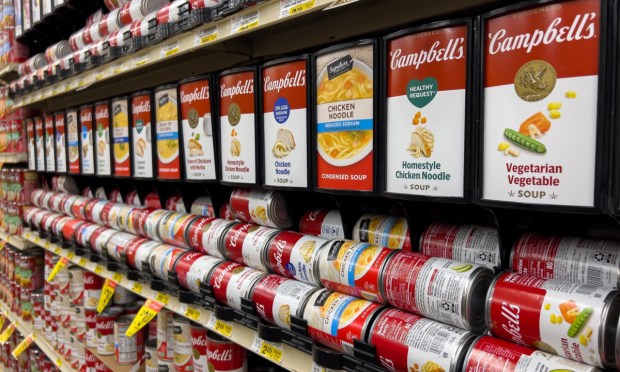Campbell Sees Inflation Sending Grocery Shoppers to the Center Aisles

As consumers look for ways to manage their grocery budgets amid continued inflation, Campbell Soup Company is seeing consumers shift away from fresh, perishable foods toward lower-cost, shelf-stable options.
The company, which spans a range of popular food lines including its namesake brand, Pepperidge Farm, Swanson and others, observed on a call with analysts Wednesday (June 7) discussing the company’s third-quarter FY2023 financial results that, as food price increases remain elevated, consumers are opting for center-aisle goods.
“We’re seeing … migration to things like shelf stable away from more expensive perimeter items,” Campbell President and CEO Mark Clouse told investors.
Certainly, many consumers are looking for ways to rein in their grocery spending. Research from last month’s edition of PYMNTS’ Consumer Inflation Sentiment series, “Consumer Inflation Sentiment Report: Consumers Cut Back by Trading Down,” for which we surveyed more than 2,000 U.S. consumers their experiences and perceptions in shopping, reveals that 57% of grocery customers have cut down on nonessential spending. Plus, 47% have switched to cheaper merchants for at least one grocery product.
Notably, consumers are shifting to cheaper merchants more often for center-aisle goods than for fresh items, challenging brands in the former category to find ways to offer greater value and challenging retailers to price competitively. The study found that 35% of shoppers have traded down for housekeeping supplies and 32% for snacks, while only 27% have done so for fresh meat.
The demand for more affordable meal options has also created an overall shift toward food at home. In fact, a PYMNTS survey of a census-balanced panel of more than 2,300 U.S. consumers in late 2022 showed that roughly 1 in 3 consumers have been purchasing from restaurants less often in response to rising prices. That share has likely only risen since then as restaurant inflation has become worse, finally surpassing grocery inflation earlier this year.
“When you think about what the consumer dynamic is right now and where the muscle really is — in center of [the] grocery [store] — we feel this area around cooking and quick meals is really the sweet spot that we want to be in,” Clouse said.
Certainly, consumers are looking for quick, convenient food-at-home options that are more affordable than ordering from a restaurant. Research from PYMNTS’ recent study “Connected Dining: Ready-to-Eat Meals Are Eating Restaurants’ Lunch,” which draws from an April Survey of more than 2,300 U.S. adults, revealed that a whopping 57% of consumers (roughly 96 million people) had bought ready-to-eat meals in previous past month.
That share is especially high for millennials, with 75% having done so and with 46% of these consumers purchasing ready-to-eat meals at least once a week.
It seems that millennials’ demand for convenient options that save them time on cooking extends to other categories beyond prepared meals. Clouse noted that Campbell’s condensed soups, for instance, have “attracted new younger consumers” to the brand.
“Within the cooking area, we continue to grow. … In particular, a lot of that growth is coming from younger households where I think there was a lot of questions on ‘Can you attract people into the condensed business that are millennials?’” Clouse noted. “And I think the answer is a clear yes.”

